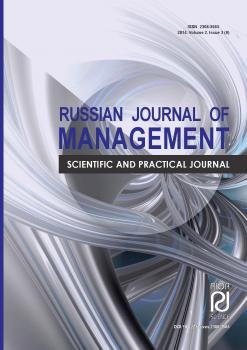employee from 01.01.2019 until now
Sankt-Peterburg, St. Petersburg, Russian Federation
student from 01.01.2022 until now
Sankt-Peterburg, St. Petersburg, Russian Federation
VAK Russia 5.2.1
VAK Russia 5.2.3
VAK Russia 5.2.4
VAK Russia 5.2.5
VAK Russia 5.2.6
UDC 353.5
CSCSTI 06.61
Russian Trade and Bibliographic Classification 787
Despite its leadership in key indicators, the socio-economic polarization of regions within the Central Federal District (CFD) necessitates the development of new comprehensive approaches to classifying its constituent subjects. This is crucial for achieving state governance goals aimed at reducing interregional disparities. The research objective is to create an original methodology for the typology of Russian Federation subjects based on the performance indicators of their heads, as approved by Presidential Decree. Its scientific and practical significance lies in providing a tool to identify regional characteristics, enabling the differentiation of management strategies and optimization of resources. Testing the methodology on CFD data for 2022-2023 led to the identification of 6 typological groups, revealing key differences, potential, and challenges of the regions, and confirming the district's pronounced polarization. The value and scientific novelty lie in the proposed universal classification approach, which comprehensively assesses regions based on both their current state and development dynamics, viewed through the lens of leadership effectiveness. The methodology is adapted to the specifics of the CFD but can potentially be applied to other districts once sufficient data is accumulated. The study highlights the connection between the activities of regional authorities and socio-economic outcomes, offering a tool for enhancing public administration
regional differentiation, classification, performance indicators, performance of regional heads, typological groups, public administration, management strategies
1. Decree of the President of the Russian Federation No. 1014 of November 28, 2024 "On the Assessment of the Effectiveness of the Highest-Ranking Officials of the Subjects of the Russian Federation and the Performance of the Executive Bodies of the Subjects of the Russian Federation".
2. Decree of the President of the Russian Federation No. 68 of February 4, 2021 "On the Assessment of the Effectiveness of the Highest-Ranking Officials of the Subjects of the Russian Federation and the Performance of the Executive Bodies of the Subjects of the Russian Federation".
3. Bufetova, A. N. (2022). [Polarization of Russia's Spatial Development: Quo Vadis?]. Mir ekonomiki i upravleniya [World of Economics and Management], Vol. 22, No. 1, pp. 103–129. DOI:https://doi.org/10.25205/2542-0429-2022-22-1-103-129.
4. Golovacheva, O. A. (2014). [On the Issue of Spatial Polarization of Regional Economies in Russia]. Sovremennye naukoemkie tekhnologii. Regional'noe prilozhenie [Modern High Technologies. Regional Supplement], No. 2 (38), pp. 47–53.
5. Zubarevich, N. V. (2010). Regiony Rossii: neravenstvo, krizis, modernizatsiya [Regions of Russia: Inequality, Crisis, Modernization]. Moscow: Independent Institute for Social Policy, 160 p. ISBN 978-5-903599-10-3.
6. Kolomak, E. A. (2019). [Spatial Development of Russia in the 21st Century]. Prostranstvennaya ekonomika [Spatial Economics], Vol. 15, No. 4, pp. 85–106. DOI:https://doi.org/10.14530/se.2019.4.085-106.
7. Leksin, V. N. (2010). [Territorial Divisions as Areas for the Implementation of Socially Significant Functions]. Trudy ISA RAN [Proceedings of the Institute for Systems Analysis of the Russian Academy of Sciences], Vol. 56, pp. 78–93. EDN: https://elibrary.ru/UTBGXF.
8. Smolyakova, A. O., & Tikhiy, V. I. (2020). [Interregional Socio-Economic Polarization and the Development of Proposals for its Reduction (Based on the Materials of the Central Federal District)]. Vestnik Voronezhskogo gosudarstvennogo universiteta. Seriya: Geografiya. Geoekologiya [Bulletin of the Voronezh State University. Series: Geography. Geoecology], No. 1, pp. 77–82. DOI:https://doi.org/10.17308/geo.2020.1/2664.
9. Rosstat. Regiony Rossii. Sotsial'no-ekonomicheskie pokazateli [Regions of Russia. Socio-Economic Indicators]. Available at: https://rosstat.gov.ru/folder/210/document/13204 (Accessed: March 19, 2025).
10. Sidorkina, M. Yu. (2016). [Retrospective Analysis of the Development of the Central Federal District Based on Regional Grouping]. Regional'naya ekonomika i upravlenie: elektronnyi nauchnyi zhurnal [Regional Economics and Management: Electronic Scientific Journal], No. 3 (47), pp. 30–38. EDN: https://elibrary.ru/YKQNFL.
11. Capello R., Caragliu A., & Fratesi U. (2014). Modeling Regional Growth between Competitiveness and Austerity Measures: The MASST3 Model. International Regional Science Review, Vol. 38, No. 1, pp. 1–38. DOI:https://doi.org/10.1177/0160017614543850.
12. Capello R., Caragliu A., & Fratesi U. (2017). Measuring border effects in European cross-border regions. Regional Studies, Vol. 52, No. 7, pp. 986–996. DOI:https://doi.org/10.1080/00343404.2017.1364843.
13. Greco S., Ishizaka A., Tasiou M., & Torrisi G. (2019). On the Methodological Framework of Composite Indices: A Review of the Issues of Weighting, Aggregation, and Robustness. Social Indicators Research, Vol. 141, No. 1, pp. 61–94. DOI:https://doi.org/10.1007/s11205-017-1832-9.
14. McCann P. (2020). Perceptions of regional inequality and the geography of discontent: insights from the UK. Regional Studies, Vol. 54, No. 2, pp. 256–267. DOI:https://doi.org/10.1080/00343404.2019.1619928.
15. Organisation for Economic Co-operation and Development. (2008). Handbook on Constructing Composite Indicators: Methodology and User Guide. Paris: OECD Publishing, 162 p. Available at: https://www.oecd.org/content/dam/oecd/en/publications/reports/2008/08/handbook-on-constructing-composite-indicators-methodology-and-user-guide_g1gh9301/9789264043466-en.pdf (Accessed: July 20, 2025).















